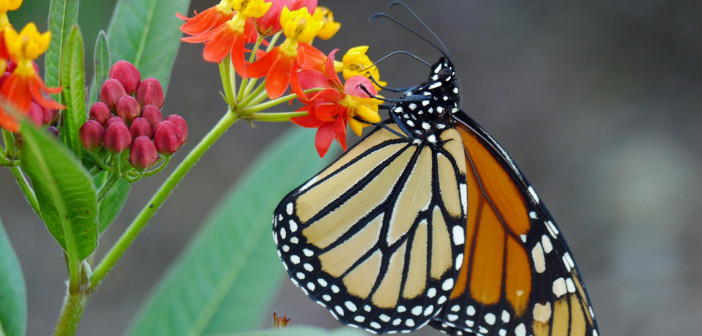Every wildlife-friendly yard should have milkweed plants. Not only because of their beneficial connection to Monarch Butterflies, which is pretty well known, but other insects love them, too. There are seventy-three species of native milkweed in the United States. and the U.S. Forest Service says that more than 450 insects are known to feed on some portion of the Common Milkweed, Asclepias syriaca, alone.
There’s also a non-native milkweed much enjoyed by Monarchs and other insects: Tropical Milkweed, Asclepias curassavica. Thought to be native to the Caribbean and Central America, it has found its way to the U.S. You may have seen it growing naturally if you live in a warm part of the country or at garden centers elsewhere. It’s a vibrant and popular plant known for its striking red and orange flowers. It’s robust, easy to grow, and has a longer blooming season than many other milkweeds. However, despite all that, conservationists recommend against using it. Here’s why:
Adverse effects of Tropical Milkweed
- Disruption of monarch migration: One significant concern with Tropical Milkweed is its potential to disrupt Monarchs’ natural migratory patterns. This milkweed, an annual in most areas, doesn’t die back in the winter in warmer climates, so Monarchs may be encouraged to stay in areas they normally wouldn’t. They need to continue their fall migration into Mexico. This potentially exposes them to colder temperatures and higher mortality rates.
- Spread of disease: Tropical Milkweed can harbor higher levels of parasites, especially the protozoan parasite Ophryocystis elektroscirrha, which can be detrimental to Monarch populations. The year-round presence of old plants can increase the chances of transmitting this parasite to the caterpillars, weakening or even killing them.
- Impact on native plant species: When introduced into non-native areas, Tropical Milkweed can potentially compete with native plant species for resources. This competition can sometimes decrease native biodiversity, affecting local ecosystems and the wildlife that depend on indigenous plant species.
Conservationists recommend planting only native species of milkweed. For those living in areas where Tropical Milkweed is native or already present, manage its growth by cutting it back in the fall. That will help mitigate some of the negative impacts, such as reducing the risk of disease transmission and encouraging Monarchs to continue their natural migratory cycle. This approach helps provide the benefits of supporting Monarchs and other pollinators while minimizing ecological disruptions.
Annuals for butterflies
Perennials for butterflies
All those plants in your yard? Surprisingly brainy!
In your yard: 27 birds to look for






